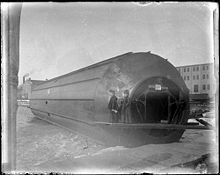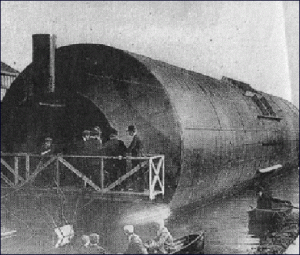The Toronto Rollerboat: Sometimes A Great Notion
Copyright © 2013, Toronto Historical Association

Anyone looking about Toronto’s current waterfront, if they can find it through the forest of condos and other high rise developments, would find it difficult to imagine that the city was once a major marine port. Freighters docked from all points carrying goods from the interior of the United States, raw materials from Canada’s west and lake head of Superior. Luxury cruise ships plied the waters carrying passengers on holiday tours and visits to both sides of the border. Today, the port of Toronto is home to mostly recreational small craft and local boaters. There was a relatively recent attempt to restart lake travel with the use of a large hovercraft ferry and a major dock/reception area on the eastern side of the city. It was not the first to have good intentions, sound fine in theory, attract public support and interested backers and not the first to be relegated to the “it should have worked” shelf.
In 1897, a prominent and successful lawyer, Frederick Knapp, from Prescott, Ontario, came up with, what he thought was a brilliant design for a boat that would whisk passengers in comfort across and around Lake Ontario. A Roller Boat! Using his skills as a dynamic speaker, honed in the courts of Upper Canada, he gathered together a number of backers from the business community and convinced them that his plan would work. He committed a considerable amount of his own funds as proof that he was serious in his intent. His design for a revolutionary new craft was certainly exciting , novel and intriguing. Though he had had some small success dabbling in inventions before, he was, in retrospect, out of his depth in thinking through his new concept. Good attorney he was, good engineer he wasn’t. Still, he was able to move well beyond the blueprints and an actual full scale prototype was undertaken.
A factory and foundry were located and equipped on the Toronto waterfront in what is now the East Portlands’ area and construction was under way.
The concept was simple. A giant double hulled cylinder would be constructed. The outer hull would rotate providing propulsion and mobility, while the interior hull would float on gyroscopes and gimbals remaining stable and unaffected by the wave action on the lake and affording the passengers a floating comfortable care free ride across the waters.
Despite its advanced concept and unique design, it lacked two things. It was a virtually sealed container, so passengers could not enjoy the view or refreshing air of the lake during the journey, claustrophobics need not book passage, and, more importantly, was underpowered. This was discovered in trials and no amount of tinkering or re-engineering could overcome the shortfall of the initial design. It just would not move as proposed, floating over the waves unaffected by the up and down motion of the water. The wind and other factors were not overcome by the design.

